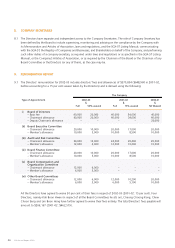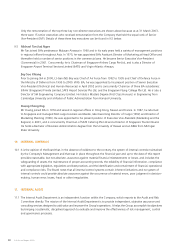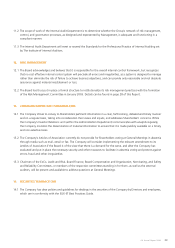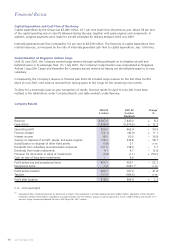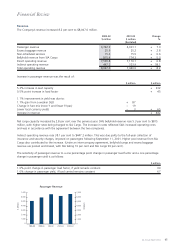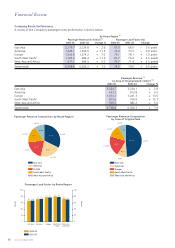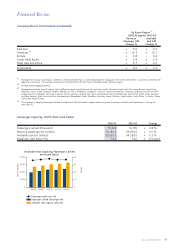Singapore Airlines 2003 Annual Report Download - page 41
Download and view the complete annual report
Please find page 41 of the 2003 Singapore Airlines annual report below. You can navigate through the pages in the report by either clicking on the pages listed below, or by using the keyword search tool below to find specific information within the annual report.39
SIA Annual Report 02/03
11.2 The scope of work of the Internal Audit Department is to determine whether the Group’s network of risk management,
control, and governance processes, as designed and represented by Management, is adequate and functioning in a
compliant manner.
11.3 The Internal Audit Department will meet or exceed the Standards for the Professional Practice of Internal Auditing set
by The Institute of Internal Auditors.
12. RISK MANAGEMENT
12.1 The Board acknowledges and believes that it is responsible for the overall internal control framework, but recognizes
that no cost effective internal control system will preclude all errors and irregularities, as a system is designed to manage
rather than eliminate the risk of failure to achieve business objectives, and can provide only reasonable and not absolute
assurance against material misstatement or loss.
12.2 The Board has thus put in place a formal structure to institutionalize its risk management practices with the formation
of the Risk Management Committee in January 2003. Details can be found in page 28 of this Report.
13. COMMUNICATIONS WITH SHAREHOLDERS
13.1 The Company strives to convey to Shareholders pertinent information in a clear, forthcoming, detailed and timely manner
and on a regular basis, taking into consideration their views and inputs, and addresses Shareholders’ concerns. While
the Company’s Investor Relations unit (within the Administration Department) communicates with analysts regularly,
the Company monitors the dissemination of material information to ensure that it is made publicly available on a timely
and non-selective basis.
13.2 The Company’s Articles of Association currently do not provide for Shareholders voting at General Meetings in absentia
through media such as mail, email or fax. The Company will consider implementing the relevant amendment to its
Articles of Association if the Board is of the view that there is a demand for the same, and after the Company has
evaluated and put in place the necessary security and other measures to facilitate in absentia voting and protect against
errors, fraud and other irregularities.
13.3 Chairmen of the ExCo, Audit and Risk, Board Finance, Board Compensation and Organization, Nominating, and Safety
and Reliability Committees, or members of the respective committees standing in for them, as well as the external
auditors, will be present and available to address questions at General Meetings.
14. SECURITIES TRANSACTIONS
14.1 The Company has clear policies and guidelines for dealings in the securities of the Company by Directors and employees,
which are in conformity with the SGX-ST Best Practices Guide.









